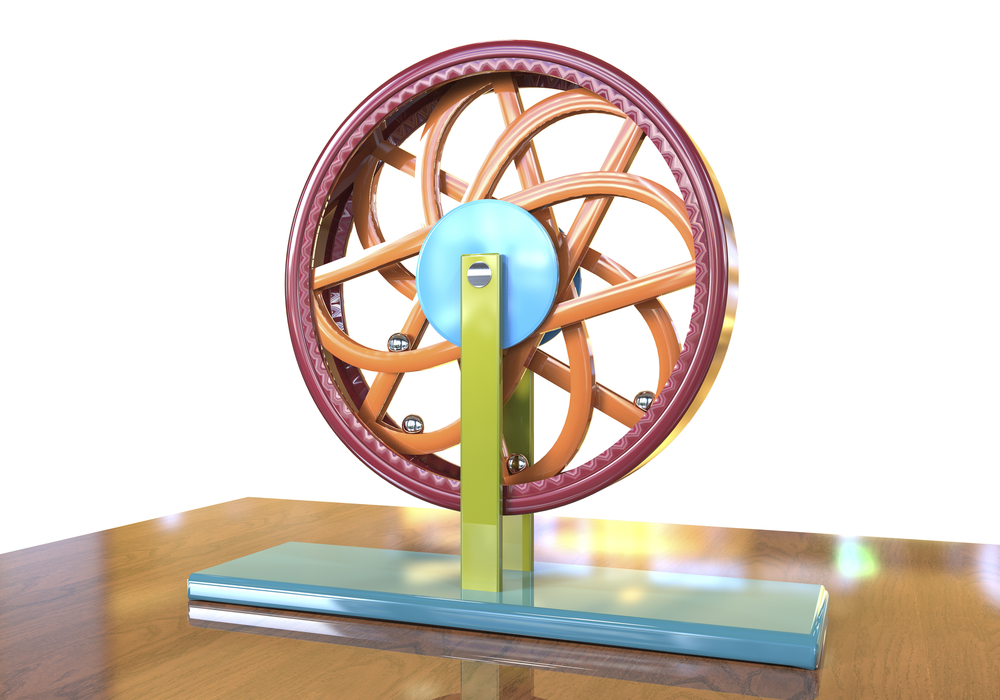

Perpetual motion machine, Perpetuum mobile, 3D illustration. 3D model is accurately made according to drawings of Leonardo da Vinci
Jubal Harshaw at the blog GrokInFullness had an excellent post last month on the minimum wage that I had missed. (HT2 Jonathan Meer.) It’s titled “The Minimum Wage as a Perpetual Motion Machine.” Here are the second and third paragraphs:
I worry that an elasticity of less than 1 can be abused by people who try to calculate the net benefits of increasing the minimum wage. I’ve seen a few studies that try to do this. They will take some estimate of the elasticity of demand from the empirical literature, count up the costs to the losers (those who lose their jobs) and the benefits to the winners (those whose wages increase) and cheer the net social benefits of the minimum wage.
Try this on for size. Let’s increase the minimum wage by 10%, which will reduce total employment of affected workers by only 1%. (Assuming -0.1 as the elasticity of demand for low wage workers.) The net effect is a benefit, because the gains to the winners are larger than the losses to the losers. Total compensation changes by (1 + 10%) * (1 – 1%) = 1.09, in other words a 9% increase. (The first term is the increase in wages per worker, the second term is the decrease in the total number of workers. Multiplying these together should give you the change in total compensation. Try it with some actual values for the minimum wage and numbers of workers to convince yourself.) Okay. So let’s keep going. Let’s raise the minimum wage by 100%. Net benefits to the affected workers are (1+100%)*(1-10%) = 1.8. An 80% increase! To boot, maybe there’s some way the winners can compensate the losers, such that everyone’s take-home pay increases! A 200% increase would yield an even bigger 140% increase! This isn’t literally a perpetual motion machine; it maxes out at a 450% increase in the minimum wage, then the net benefits start coming back down. But the notion that someone could take the logic of small increases and extrapolate them this far is alarming. It implies that there’s something fundamentally wrong with this approach. That fundamental error is present even for small changes, but the smallness allows minimum wage advocates to paper over it.
He goes on from there. The whole thing is well worth reading.
I’ll point out, though, that even if the problem he identifies with the way of thinking above were not a problem, there would be another huge problem: the cost/benefit analysis looks only at a subset of winners and losers. The other two groups that lose are employers and consumers of the products that the employers produce. And in case you think they don’t count (I disagree with you), remember that many of the products produced by low-wage workers are bought by low-wage workers.

READER COMMENTS
Jackson Mejia
Apr 9 2019 at 4:37pm
Well, I guess now advocates of minimum wage increases have a solid answer when asked why they don’t increase it to $20, $50, $100, $1000, and so on. Now they can just say we can actually increase it 450% without making people worse off! But I suppose they would have to answer why they only want to double the wage then, and that answer wouldn’t be a very good one.
More seriously, my understanding of these elasticity estimates is that they are only accurate in a small neighborhood of where equilibrium hypothetically occurs. As a result, it is inadvisable to use them for anything more than what seem to be small changes in wages/employment. Are there many examples of economists/pundits actually abusing these numbers?
John Warner
Apr 9 2019 at 5:07pm
Read Jacob Mincer’s paper in Journal of Political Economy circa 1976 — the definitive paper for analyzing whether a MW increase makes workers as a group better off or worse off. If the former (latter), labor force participation increases (decreases). His empirical analysis unequivocally shows the latter. One of the best papers on MW ever written.
john hare
Apr 9 2019 at 7:41pm
Either I missed it or there was no consideration of future lost earnings from those that become unemployed. Unemployed now and lose income, but also lose job experience that could put one well above minimum at some point in the future. I wonder if the employment loss may be understated in these studies for a future point in time.
Or is it assumed that the employment rates will adjust up as inflation nibbles at the buying power of the increase?
Ike
Apr 10 2019 at 7:35am
Left out of this is the moral component. Why are we to assume that “net societal benefit” is a proper calculation here?
Would it be proper for nine people to show up at someone’s door, and say “Hey Linda, sorry about you losing your job. But we all got little raises out of it, so we are happy, and we think our increased marginal happiness is more than enough to counteract your feelings of hunger, uselessness, and hopelessness. Enjoy your time off, we have to get back to work.”
Thaomas
Apr 10 2019 at 10:20am
Indeed there is something wrong with extrapolating the net benefits from a 10% increase in a minimum wage to a 100% increase. It’s unlikely the elasticity is the same.
As for the incidence of the minimum wage on low income consumers, by all means count that on the cost side of the measure.
If those who understand the costs of minimum wages would engage in the measurement of these costs they would have more success in getting a wage subsidy or EITC adopted as better ways to raise the incomes of low income workers.
John Eleazarian
Apr 10 2019 at 4:07pm
John Hare makes an excellent point above about job losses leading to loss of experience that could qualify one for a better job.
People need to understand that a small increase in the minimum wage differs qualitatively from the proposed large increases. The latter have the effect of outlawing current minimum wage jobs. This effect robs the least qualified new entrants to the labor market of a way to get paid training. Instead, we can expect — and have seen — the rise in unpaid internships, which the impecunious cannot afford.
David Seltzer
Apr 10 2019 at 4:43pm
David, I posted this yesterday on John Cochrane’s Grumpy Economist.
Butterfly effect; sensitive dependence on initial conditions in which a small change in one state of a deterministic nonlinear system can result in large differences in a later state. I suspect minimum wage laws not only affect dropouts, who need not apply today, but affect their progeny in the future. The negative effects of minimum wage laws observed today, will be greatly exaggerated in the future. If economics is the science of recognizing secondary consequences, it’s the science of of tracing the effects, noun, of some proposed policy not only on employees in the short run, but on the general economy in the long run. The failure to understand the common sense of economics brings complicated sophistries and disastrous policies based on them.
Thaomas
Apr 11 2019 at 12:47pm
I sort of agree with this. So why do opponents of minimum wages trace out and quantify these secondary and tertiary, etc consequences and show that when rightly considered, the costs of a minimum wage are negative? Or, recognizing that the costs are so much greater than others see, why does this not add urgency to their advocacy of other, less costly ways of increasing low income workers incomes like a higher EITC or something else they might think of that would not generate the secondary, tertiary, etc costs?
Mark Z
Apr 11 2019 at 12:18am
A concern I have about inelasticity: I think goods that are more inelastic will tend to be more necessities (in extreme cases, Giffen goods) than luxury goods, and therefore the price increase caused by the wage increase is primarily borne by poor people, and in the end it therefore amounts mostly to a redistribution from poor people qua employees to poor people qua consumers.
Comments are closed.